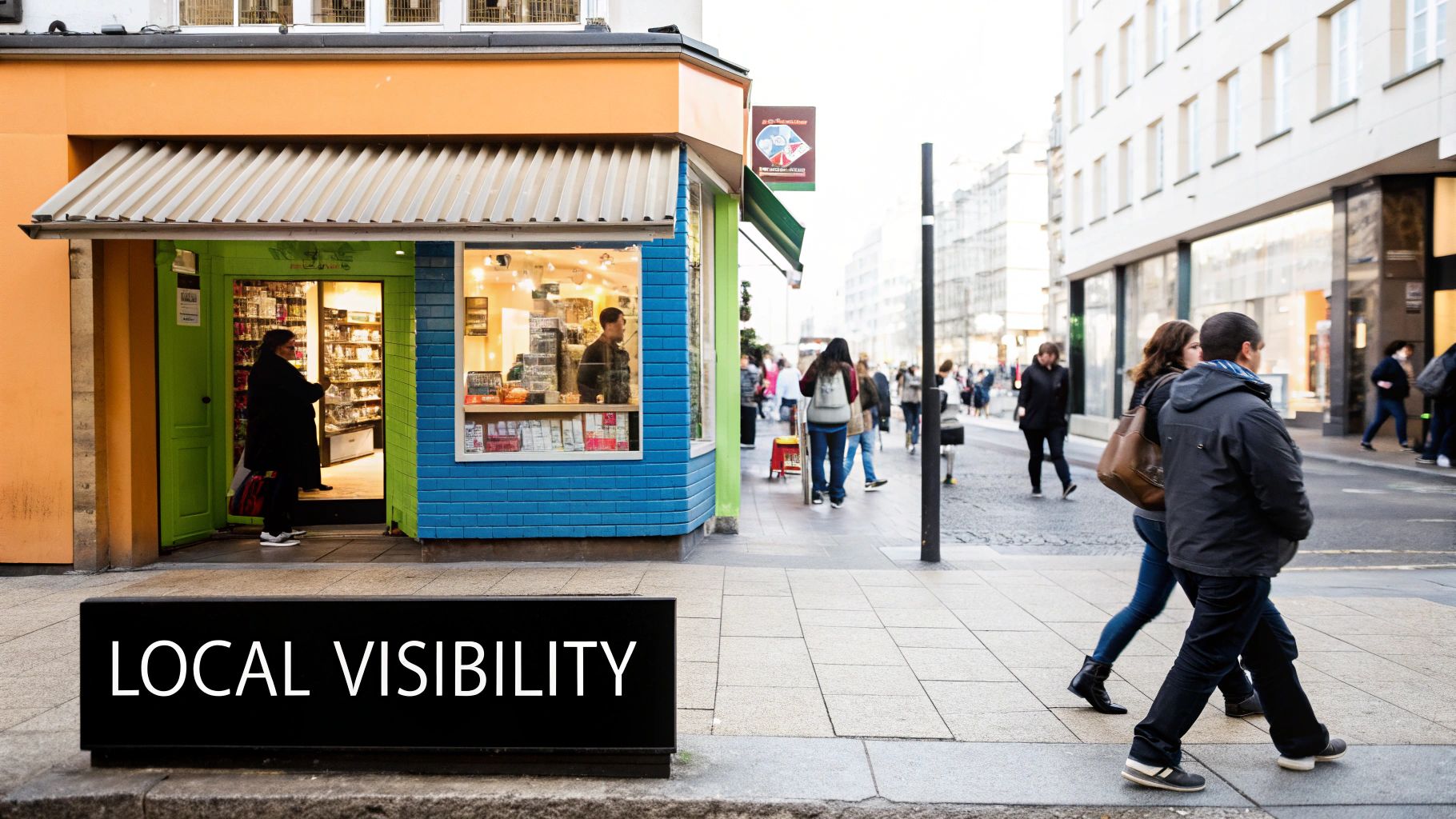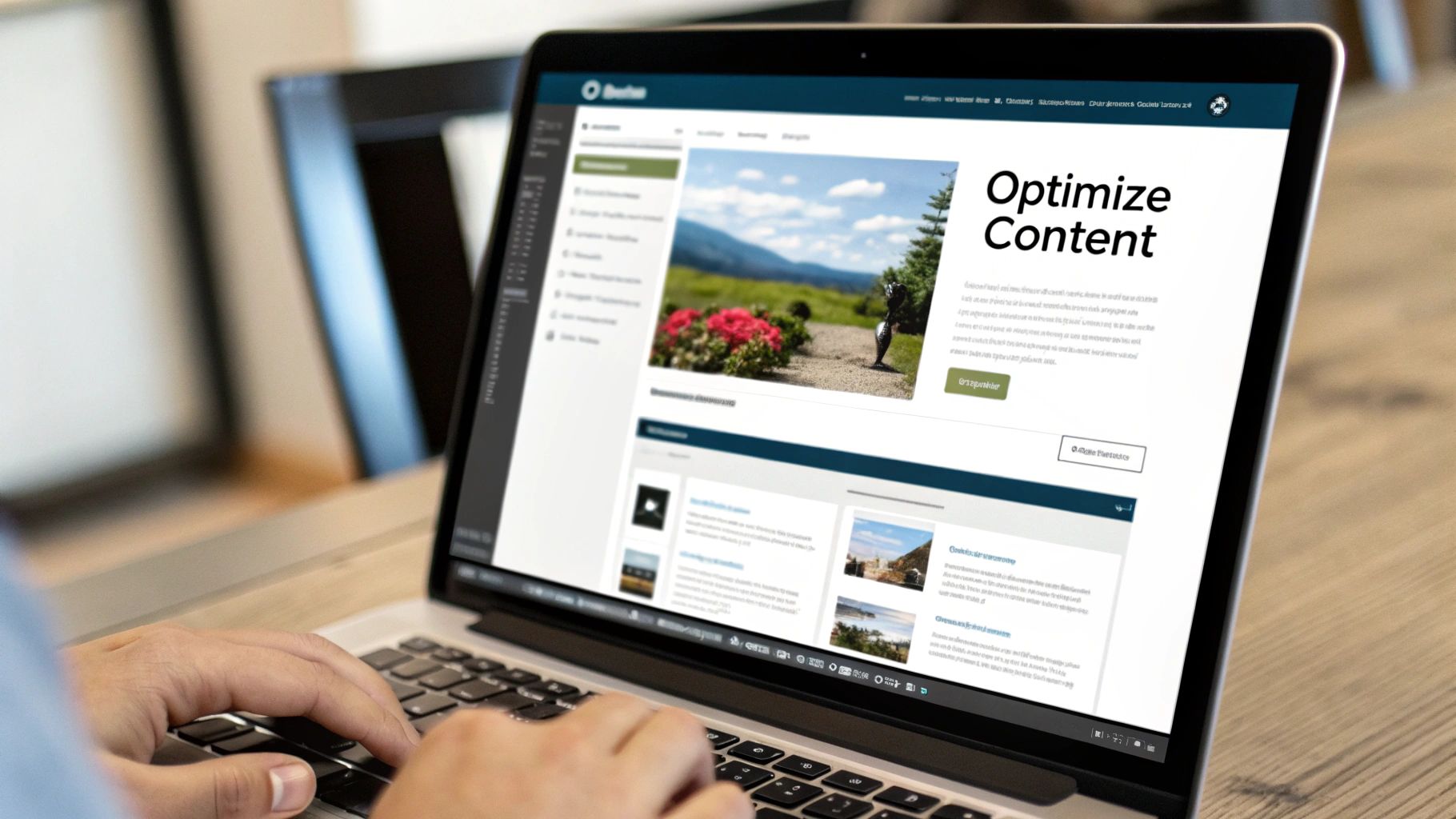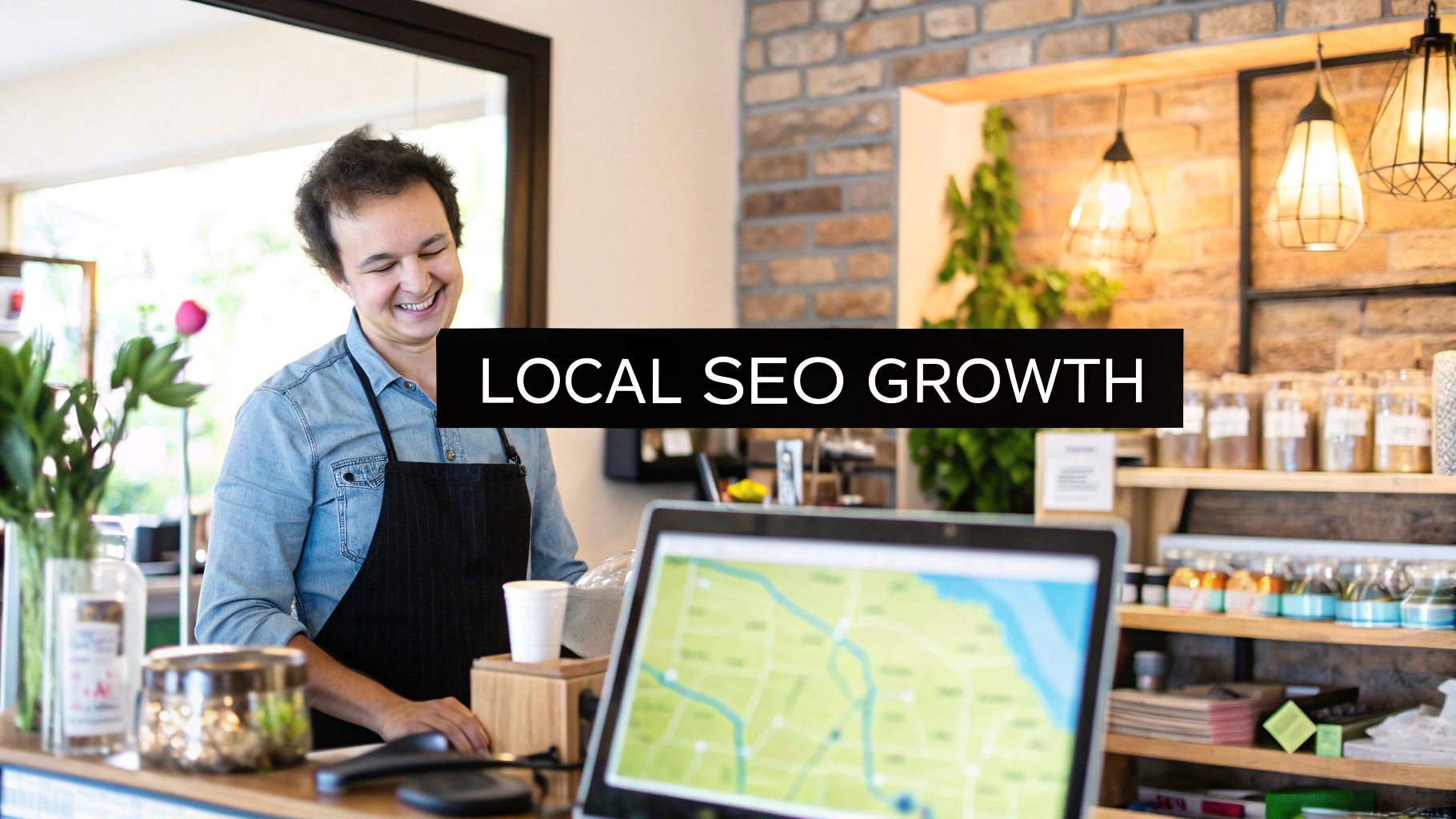Why Local SEO Changes Everything for Small Businesses

Let’s skip the complicated jargon. For a small business, local SEO isn’t just another item on your ever-growing to-do list; it’s the crucial factor that determines whether you flourish or just get by. It’s why the café down the street is always packed on a Tuesday afternoon while yours is still waiting for the lunch rush. This isn’t about outsmarting a complex algorithm; it’s about being visible when people in your immediate area are actively searching for what you offer.
Put yourself in your customer’s shoes. When someone in Norwich needs a reliable plumber, or a family in Ipswich fancies trying a new restaurant, what do they do? They pull out their phones and search. They aren’t interested in a plumber from Manchester; they need someone local, trustworthy, and available right now. This is where local SEO becomes your secret weapon, allowing you to stand shoulder-to-shoulder with big national chains that have massive marketing budgets.
The Shift from Foot Traffic to Finger Taps
The journey a customer takes to find a local business has changed fundamentally. The classic high street walk-in is now more likely to start with a digital “stroll” on Google Maps or a quick search for “best coffee near me”. The numbers back this up: a huge 46% of all Google searches have what we call ‘local intent’. This means nearly half of all people on Google are looking for a business or service in their vicinity. For a small business in the UK, that’s not just data; it’s a direct connection to your next customer.
What’s more, 88% of these local searches happen on a mobile phone, showing just how immediate and on-the-go these needs are. This behaviour leads to real business, and fast. An incredible 78% of local mobile searches result in a purchase, and 88% of people will call or visit a business within 24 hours. This powerful link between a simple search and a real-world sale is the heart of local SEO for small business. Ignoring this is like locking your front door during opening hours. You can dig deeper into these consumer habits in this insightful report on local search statistics.
To put this into perspective, let’s look at how these search behaviours translate into real-world business performance. The table below breaks down the key statistics and what they mean for your bottom line.
| Search Behaviour | Percentage | Business Impact |
|---|---|---|
| Searches with Local Intent | 46% | Nearly half of all Google users are potential local customers looking for you. |
| Local Searches Resulting in a Purchase | 78% | This high conversion rate means visibility directly translates into sales. |
| Mobile Users Visiting a Store Within 24 Hrs | 88% | You can capture customers who have an immediate need to buy. |
| Verified Google Profiles Views (Avg.) | 21,643 | A well-managed profile can attract significant attention over a year. |
As you can see, the connection between online searching and offline spending is undeniable. Being visible at the moment of need is what drives growth.
Real Growth Stories, Not Just Theories
The results of a solid local strategy aren’t just theoretical; they are real and measurable. Imagine a small, independent bookshop in Cambridge finding it tough to compete with online giants. By simply optimising its Google Business Profile and encouraging reviews from local patrons, it began to appear in searches like “bookshops in Cambridge.” Suddenly, it was discovered by tourists and students who would have otherwise walked right past.
Or take the electrician in Diss, Norfolk, who saw a 50% increase in phone calls after making sure their business name, address, and phone number were listed correctly and consistently across all major UK directories. These aren’t lucky breaks. They are the direct outcomes of a strategic choice to be visible where local customers are actually looking. This turns your online presence from a static digital poster into a dynamic tool that brings in customers, transforming quiet days into profitable ones and building a loyal local following.
Transforming Your Google Business Profile Into a Customer Magnet
Think of your Google Business Profile (GBP) as your digital shopfront. For many potential customers, it’s the very first time they’ll come across your business. The trouble is, many small business owners treat it as a “set it and forget it” chore, simply ticking a box and moving on. This is a huge missed opportunity. A neglected profile is like a dusty, uninviting window display, while a fully optimised one can be your best salesperson, working 24/7 to bring in and convert customers.
The real difference between an average profile and a great one is in the detail. It’s not just about getting your name and address right; it’s about building a rich, informative hub that answers questions before they’re even asked and builds immediate trust. Getting this right is a cornerstone of any effective local SEO for small business strategy.
Going Beyond the Basics
To make your profile truly work for you, you have to treat it like the dynamic marketing tool it is. Let’s start with the visuals. Your logo is a given, but what really encourages someone to walk through your door are photos that show what it’s genuinely like to be a customer.
- Show the Experience: Add high-quality photos of your shopfront, the inside of your business, your team doing what they do best, and your products or services in use. For example, a local bakery should feature mouth-watering pictures of fresh pastries and happy customers enjoying a coffee, not just a static image of their logo.
- Keep It Current: Add new photos regularly. This shows Google your business is active and gives customers a reason to keep checking in.
Next up is your business description. This isn’t just a space to list what you do; it’s your chance to tell your story. Avoid a boring list of services. Instead, write a compelling narrative. For instance, rather than “Plumbing and heating services,” try something like, “A family-run plumbing business serving Norfolk for over 20 years, we pride ourselves on reliable, friendly service when you need it most.” This creates an instant connection. Moving past the initial setup is key to truly mastering Google Maps lead generation.
Engaging Directly With Your Customers
Two of the most powerful—and often ignored—features of a GBP are Posts and the Q&A section. Google Posts are like mini-adverts that pop up right on your profile. Use them to shout about special offers, new products, or upcoming events. A post has a limited shelf life, so posting consistently keeps your profile looking fresh and gives people a reason to choose you over a competitor with a dormant profile.
The Q&A section is your chance to get ahead of common customer questions. If people often ask about parking, your hours on bank holidays, or if you’re dog-friendly, add these questions and answer them yourself. It not only saves your customers time but also shows you’re paying attention to their needs. You can discover more powerful techniques in our guide to the 7 local SEO solutions you need to know about.
The data backs this up. Research shows that 72% of people use Google Search specifically to find local businesses. In the UK, this trend is even more pronounced, with “near me” searches having grown by over 900% in recent years, highlighting a clear demand for immediate, local options. By actively managing your GBP, you are putting your business directly in front of this massive audience. You can learn more about how customers search by checking out these comprehensive local SEO statistics. This hands-on approach turns your profile from a simple listing into a powerful tool for winning new business.
Building Citation Authority That Actually Matters
Once your Google Business Profile is polished and ready, it’s time to build its reputation across the web. This is where citations come into play. Think of them as digital breadcrumbs leading back to your business. Each time your business name, address, and phone number (often called NAP) are mentioned on another website—like a local directory, industry association, or news site—it acts as a vote of confidence. For Google, consistent and accurate citations confirm your business is legitimate, has a fixed location, and is an active part of the local community.
However, many small business owners make the mistake of chasing every directory under the sun, wasting precious time on listings that deliver zero value. The key isn’t quantity; it’s quality and consistency. A single incorrect phone number on a major directory can create more confusion for search engines than ten correct listings on obscure sites. This is one of the more subtle but damaging issues you can encounter; you can read more about other common mistakes in SEO and how to avoid them in our related guide.
Auditing and Prioritising Your Citations
Before you start building new citations, you have to find and fix the ones that already exist. Inconsistencies often crop up from old addresses, previous phone numbers, or even slight variations in your business name (“Ltd” vs “Limited”). Start by manually searching for your business on major UK directories. A good starting point would be:
- Yell
- Thomson Local
- The Independent Business Directory (ibd-uk.co.uk)
- Your local Chamber of Commerce
I recommend creating a simple spreadsheet to track your NAP on each site. Note any inconsistencies—even a misplaced comma—and prioritise fixing them. Once your core listings are clean, you can focus on building new, high-value citations. Don’t just aim for generic directories; think about what makes sense for your specific business.
For example, a local plumber in Suffolk would gain far more authority from a listing on a trusted trade site like Checkatrade than from a generic national business aggregator. Likewise, a boutique in Norwich should be listed on local tourism and shopping guides. This targeted approach is a core principle of effective local SEO for small business.
To help you get started, here’s a table of essential UK directories that are worth your time.
Essential UK Local Directories for Small Business
Comparison of top UK local directories showing authority, cost, and submission requirements
| Directory Name | Domain Authority | Submission Type | Key Benefits |
|---|---|---|---|
| Yell | High (80+) | Free & Paid Options | Strong brand recognition in the UK, high traffic, and trusted by Google. |
| Thomson Local | High (70+) | Free & Paid Options | A long-standing, authoritative directory that adds significant trust. |
| The Independent Business Directory | Medium | Free | Specifically for UK small businesses, offering a relevant and targeted link. |
| Scoot | Medium | Free | Part of a network that includes The Sun and The Independent, offering wide distribution. |
| Your Local Chamber of Commerce | Varies (often high) | Membership-Based | Hyper-local and highly authoritative signal of community involvement. |
This table shows that you don’t need a huge budget to get listed on powerful sites. The main takeaway is to focus your efforts on directories that are recognised and trusted within the UK.

As this data shows, a complete and consistent online presence, which citations help to build, directly translates into more customer engagement. Every correct citation is another piece of evidence reinforcing your business’s credibility.
Finding Niche and Hyper-Local Opportunities
The best citation opportunities are often those your competitors have missed. Look for websites specific to your industry or town. Are there local bloggers who review businesses like yours? Does your town have an online community forum or event calendar where you can get mentioned?
These hyper-local mentions send powerful relevance signals to Google, demonstrating that you are an integral part of the local fabric. Building this authority takes time, but it creates a strong, defensible advantage that sets you apart from competitors who only focus on the big-name directories.
Making Your Website Speak Google’s Local Language

Once you’ve built a solid foundation with local citations, it’s time to turn your attention inwards to your own website. Your site might look fantastic to a human visitor, but if it isn’t speaking Google’s specific “local dialect,” you’re effectively invisible to potential customers searching for what you offer. Optimising your website for local search means more than just dropping your postcode on the contact page—it’s about weaving your location into the very fabric of your site so Google sees you as a genuine local authority.
This is a non-negotiable part of any local SEO for small business plan. It’s all about sending clear signals to search engines about where you operate and the community you serve. Without these signals, you’re just another business online, fighting for attention on a global stage instead of becoming the go-to choice in your own backyard. The aim is to make it incredibly easy for Google to see a search like “electrician in Norwich” and immediately connect it to your website.
Weaving Your Location into Your Website
First things first, let’s get your core on-page elements sorted. This is about strategically placing your location in the key spots search engines check for context. If your business has a single location, this is quite straightforward.
- Title Tags: This is the main headline that shows up in browser tabs and search results. Your homepage title tag should ideally feature your main service and your location. For example, a jeweller’s might use: “Bespoke Jewellery & Repairs in Brighton | The Silver Guild”.
- Meta Descriptions: Although not a direct ranking factor, a well-written meta description that mentions your location can seriously boost your click-through rate. It shows searchers you’re local before they even click.
- Homepage Content: Make sure your main location (e.g., “Diss, Norfolk”) appears naturally in the text on your homepage. It works well in the introduction and near any call-to-action buttons.
Another simple but powerful signal is embedding a Google Map on your contact page. This visually confirms your location for users and adds an interactive element that search engines appreciate. Think of it as dropping a digital pin on the map for both your customers and the search engine crawlers.
Advanced On-Page Localisation
To really pull ahead of the competition, you need to move beyond the basics and create content that solidifies your local identity. This is where you can make your business truly stand out. If you serve several different areas, think about creating location-specific pages. For example, a cleaning company that covers both Norwich and Ipswich should have a separate page for each city, outlining the specific services offered there. This stops search engines from getting confused and gives users content that is directly relevant to them.
Another smart move is to use local schema markup. This is a snippet of code you add to your website that hands search engines your business details—like your address, opening hours, and phone number—on a silver platter. It’s a structured format that they can easily read and understand. Don’t worry, you don’t need to be a coding whizz; many website platforms and plugins can generate this for you. Adding schema is like giving Google a perfectly organised business card; it makes its job easier and increases the chance of your information showing up in special search results. In a competitive local market, this technical touch can be a real game-changer.
Turning Reviews Into Your Competitive Advantage
Customer reviews are one of the most powerful tools you have for local SEO. They go way beyond simple social proof; they’re a direct signal to Google about your credibility, a massive trust-builder for potential customers, and a real driver of sales. Too many businesses only think about reviews when a bad one pops up. A smarter approach is to be proactive, which can give you a serious, consistent edge over your local competition. The trick isn’t being pushy; it’s about knowing the perfect moment to ask.
Timing is absolutely crucial. The best time to ask for a review is right after you’ve delivered a brilliant result or created a memorable experience. For a hairdresser, it’s that moment when a client sees their new style in the mirror and their face lights up. For a builder, it’s when the homeowner is admiring the finished work with a huge smile. This is when goodwill is at its peak, and customers are most inclined to share their positive feelings.
From Feedback to Fuel
Responding to reviews is an art form, and it’s just as vital as getting them in the first place. Every single reply is a public display of your customer service.
- Positive Reviews: Always say thank you and make it personal. A simple “Thanks for the review” won’t cut it. Mention a specific detail from their comments to show you’ve actually read it. For instance, “So glad you enjoyed the steak pie, Sarah! It’s one of our head chef’s favourites.” This personal touch reinforces their good experience and encourages others.
- Negative Reviews: This is where you can truly stand out. A professional and empathetic response can often win back the unhappy customer and impress anyone else reading. Acknowledge their problem, offer a genuine apology, and suggest a clear way to resolve the issue offline. Whatever you do, don’t get drawn into a public argument.
By managing your feedback this way, you turn customer opinions into a core part of your marketing. For businesses in East Anglia, building this local trust is essential. Our team has plenty of experience helping firms with their complete digital marketing in Norfolk to do just that.
Advanced Review Strategies
Don’t just let those glowing reviews sit on your Google profile. Put them to work! Share fantastic testimonials on your social media pages or feature them right on your website’s service pages. These authentic endorsements are often far more convincing than any marketing copy you could write.
On a more technical note, you should implement review schema markup on your website. This is a bit of code that helps Google understand your reviews. It’s what can make those gold star ratings appear right next to your business in the search results. This small addition can dramatically increase your click-through rate, as people are naturally drawn to listings with visible proof of quality. By embracing reviews as an active part of your strategy, you turn customer feedback from a passive score into a powerful engine for growth.
Building Local Connections That Boost Your Rankings

Once your website and Google profile are in good shape, it’s time to look beyond your own digital properties. The next level of a strong local SEO for small business strategy is all about creating genuine relationships within your community that have a positive online effect. This isn’t about finding sneaky ways to trick Google. It’s about earning high-quality backlinks—links from other websites to yours—by becoming a known and respected player in your local area.
Think of it like a real-world referral. When another local business, a community news site, or a well-known local blogger links to your website, they’re essentially telling their audience (and Google) that you’re trustworthy. These authentic connections are far more valuable than any quick-fix link scheme because they’re based on real partnerships and mutual respect.
Finding Link Opportunities That Make Business Sense
The most effective local links often come from relationships that are valuable on their own, even without the SEO perk. Start by thinking about other local, non-competing businesses that serve the same type of customer. A wedding photographer in Suffolk, for example, could team up with a local florist, a popular venue, and a cake maker. Together, they could create a “Suffolk Wedding Guide” blog post. Each business could write a section for their own blog and link out to their partners. This creates powerful local links and provides a genuinely helpful resource for engaged couples.
Here are a few other practical ways to earn great local links:
- Sponsor a local event: Putting your name on a local charity fun run, a school fete, or a community festival nearly always gets you a link from the event’s webpage.
- Host a workshop or event: A local accountant could run a free “Small Business Tax Basics” workshop. They could then ask the local business association to promote it, which would likely include a link to the sign-up page.
- Join local business groups: Your local Chamber of Commerce or other networking organisations often have member directories that provide a high-authority link from a relevant local source.
Becoming a Local Resource
Another great approach is to create content that local journalists, bloggers, and organisations will actually want to share and reference. For instance, a local estate agent in Norfolk could put together an annual report on property price trends across different towns like Diss, Wymondham, and Attleborough. This report then becomes a go-to resource that local news outlets might cite and link to when they write about the housing market. By meeting a local need for information, you attract links naturally.
This kind of organic visibility is incredibly cost-effective. Paid ads require constant spending, but a solid local SEO foundation drives qualified traffic without the ongoing cost. In fact, organic search is responsible for over 53% of all website traffic. Getting on that first page is vital, as research shows a tiny 0.63% of Google users ever click to the second page. For UK small businesses, the brand trust and customer flow from these organic efforts provide a real competitive edge. You can find more details on how local SEO provides value for small businesses in the UK.
Your 90-Day Local SEO Implementation Roadmap
Knowing what to do is one thing, but actually doing it is what gets results. Let’s break down everything we’ve talked about into a practical, 90-day plan. I’ve designed this as a flexible roadmap, not a rigid schedule, so even the busiest small business owner can build momentum with manageable weekly goals. The trick is to start with the foundational tasks that bring the quickest wins, setting you up for long-term growth.
Month 1: The Foundation (Weeks 1-4)
The first month is all about getting your digital house in order. We’re not diving into complex link building or churning out blog posts just yet. The main goal here is to create a clean, consistent, and detailed presence where your customers are already searching. This is the bedrock of any solid local SEO strategy.
- Week 1: Perfect Your Google Business Profile (GBP): It’s time to get forensic with your GBP. Go through every single section and aim for 100% completion. This means choosing all relevant business categories, writing a description that sells your services, uploading at least 10 high-quality photos (your shop, your team, your work in action), and even pre-filling the Q&A section with common customer questions.
- Week 2: The NAP Audit: Open a simple spreadsheet and list your business Name, Address, and Phone number (NAP) exactly as it appears on your Google profile. Now, search for your business on key UK directories like Yell, Thomson Local, and Scoot. Make a note of any differences—an old address, a wrong phone number—and get them corrected. Consistency is key.
- Week 3: Core Website Optimisation: Have a look at your website’s homepage. The title tag should include your main service and town (for instance, “Bespoke Garden Design in Diss, Norfolk”). Write a compelling meta description that also mentions your location. Finally, make sure you have an embedded Google Map on your contact page.
- Week 4: Kick-start Your Reviews: Think of five happy customers from the past few months. Reach out to them personally and ask if they’d mind leaving a review on your Google profile. It helps to have a simple, polite email template ready to go. The aim is to start building that all-important social proof.
Month 2: Building Authority and Content (Weeks 5-8)
With your foundation firmly in place, it’s time to build on it. This month is about showing off your expertise and growing your digital footprint in a way that truly matters to local customers.
- Weeks 5-6: Hyper-Local Citation Building: Look beyond the big national directories. Your goal is to find two or three highly specific or local citation opportunities. This could be a listing on your local parish council website, a spot on an industry-specific trade directory, or a profile with a local business networking group you’re part of.
- Weeks 7-8: Create Your First Local Content Piece: Write one genuinely helpful blog post that answers a common question your local customers have. For example, a roofer in Suffolk could write a post titled, “Choosing the Right Roof Tiles for Suffolk Weather.” This positions you as a local expert, not just another service provider.
Month 3: Amplification and Analysis (Weeks 9-12)
Now we amplify what you’ve done and start looking at the results. This final month of the initial push is about extending your reach and figuring out what’s working so you can do more of it.
- Weeks 9-10: Local Partnership Outreach: Find one non-competing local business that you could team up with. This could be a cafe, an estate agent, or another tradesperson. Propose a simple collaboration, like sharing a promotion on social media or swapping guest blog posts.
- Weeks 11-12: Review and Refine: Dive into the free insights on your Google Business Profile. What search terms are people using to find you? Are they clicking for directions or looking at your photos? Use this information to guide your next content ideas and take a moment to celebrate your progress. You’ve just laid a powerful foundation for ongoing success.
Feeling like this is a lot to manage on your own? The team at Ibertech Solutions specialises in creating and running these exact strategies for small businesses across Norfolk and Suffolk. We can handle the technical details so you can get back to what you do best. Get in touch with us today for a free consultation and let’s build your local presence together.





